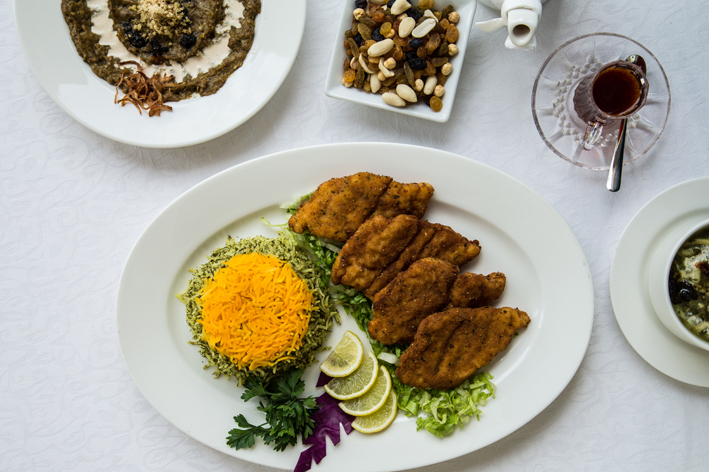
The Iranian community in Muscat recently celebrated the Persian New Year in their own special way, and the exclusive traditional menu added to the revelry. Start with fresh bread and herbs, along with mast khiar, and kashk bademjan. While mast khiar is a simple traditional Iranian side dish made of mint, cucumbers, yoghurt and flavoured with mint to be served with rice or bread, kashk bademjan is a delicious blend of fried eggplant, fried garlic, and onion, and flavoured with fried mint, and crushed walnuts. It is served with kashk or whey. Eggplant is widely used in many Persian dishes and this one especially has found its way to almost every Persian home or restaurant in town. Served with lavash, a kind of Persian bread, kashk bademjan can be eaten warm or at room temperature. And if you do not have lavash, it can also be had with toasted pita bread, flat bread, or baguettes.
Next to follow is ash reshteh, a delicious hearty soup that is traditionally prepared to welcome the Persian New Year. It is a thick vegetable and noodle soup believed to bring good fortune and is mostly served with whey and sometimes with vinegar. Packed with pulses and vegetables like kidney beans, parsley, spinach, and coriander, along refreshing burst of fried mint and garlic, this soup is served warm.
The main course dish is sabzi polo mahi, a combination of fresh dill with rice and fried fish. Sabzi polo or pilaf is a herbed rice dish and the green colour comes from a variety of herbs that is used in its making for the added flavour. Served with fried fish, sabzi polo mahi, is again a celebratory new year cuisine. Herbs like fenugreek leaves and garlic chives are used. Coupled with choice of soft drinks, the befitting end of this meal is with assorted Iranian sweets and tea.
[email protected]
Where to Go
Persepolis
Madinat Al Sultan Qaboos
Contact: +968 2469 9054
persepolis-oman.com
Sabzi Polo Mahi
For Sabzi Polo
Ingredients
• 1&1/2 cups long-grain basmati rice
• 1 bunch of spring onions, coarsely chopped
• 1 bunch of fresh dill, coarsely chopped
• 1 bunch of fresh parsley, coarsely chopped
• 1 bunch of fresh coriander, coarsely chopped
• 1 whole leek, cut into chunks
• 1 small onion
• 3 cloves of garlic
• 1 bunch of fresh mint, coarsely chopped
• 2&1/2 cups water or vegetable broth
• 1tsp saffron, ground and dissolved in 2tbsp hot water
• 2 tbsp Greek yoghurt
• 2 tbsp butter
• 1tsp ground cinnamon
• 1 lime
Preparation
• Soak rice for 5-6 hours.
• Take spring onions, dill, parsley, coriander, leek, onion, and garlic and blend. Pulse greens together until all is finely chopped and combined.
• Drain the soaked rice and cook in vegetable broth till the rice has softened.
• In a small bowl, take a ladle-full of cooked rice and mix together with 1 teaspoon of saffron water and Greek yoghurt.
•Mix together until you get a thick -ened yellowish pudding-like consistency to the rice.
• In a pot heat 1tbsp of butter until it has melted. Once melted, spread the yellow yoghurt rice along the bottom and simmer on low heat for 3-4 minutes as you prepare the other ingredients.
• Alternate the cooked rice and freshly chopped greens in your stockpot. Start with a ladle of cooked rice followed by a ladle full of chopped green stacked on top.
• Continue until all rice and greens have been added in the pot.
• Using a chopstick or something similar, poke small holes into the pyramid.
• Cook this over medium heat for 10 minutes.
• Drizzle 1tsp of saffron water over the pyramid and sprinkle the ground cinnamon.
• Cover and simmer on low heat for another 50 minutes.
• Serve with lemon slices.
For Mahi
Ingredients
• 1/2 cup chickpea flour
• 1tsp ground cinnamon
• 1tsp sea salt
• 1tsp black pepper
• 500g white fish fillets
• 3 tbsp ghee
Preparation
• Take chickpea flour, cinnamon, sea salt and black pepper together. Mix well.
• Dredge your fish fillets into the flour mixture.
• Heat a skillet over high heat and add ghee.
• Once very hot, add your fillets to the pan and fry on each side until golden brown.
• Serve with sabzi polo.